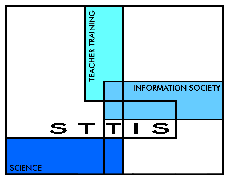Workshop 1
 Contents Contents
|
Section B Learning about the innovation
Activity
B8 Fuels and food |
|
Aims
-
To explore the differences between using an electrical
current to make water hotter and to electrolyse it.
-
To use this example to introduce abstract pictures
showing energy being stored and released during chemical change.
-
To apply these ideas to examples involving the use
of fuels and foods.
Background
The pictures introduced here are probably the most
difficult so far, since they are not just representing familiar changes
in a new way (e.g. a hot object cooling or a moving object slowing down).
They require pupils to look at a change in a completely new way.
The essential idea is that energy can be stored by making molecules move
faster or by splitting molecules apart. The particular example chosen
is water, and this can be accompanied by practical demonstration.
Using a power pack to drive the changes, water may be made hotter, or electrolysed
to form hydrogen and oxygen. These are both ways of storing energy.
Each of the reverse processes 'just happens' and can be used to drive other
changes. (N.B. A mixture of hydrogen and oxygen is explosive
and needs to be handled with great caution. It must never be put
into a container.) A soap bubble containing the gases may be exploded
- it makes a very loud bang - and strongly suggests the idea of energy
being released as the 'pulled apart' oxygen and hydrogen join back together.
What to do
1. Read through the OHTs on page
3, page 4 and page
5 which introduce the ideas. The first OHT summarises the changes,
the second looks at what is happening in terms of particles and the third
looks at what is happening in terms of energy. A commentary on these changes
is given on page 2.
2. Do the activity on page
6 by matching the changes to the pictures and check your answers on
page 2. Discuss the questions on this
page in your group. In doing this activity with pupils, it is helpful to
discuss with pupils in what ways changes A and B are similar and in what
way they are different. What would you say? What are the similarities and
differences between changes C and D?
3. Page 7 shows a
set of changes in which energy is being stored or released (things warming
and cooling, starting to move and stopping, and energy being stored or
released during chemical change). Match these change to the appropriate
abstract pictures on page 8. Then check your
answers on page 2.
4. On page 9,
there are some examples of statements made by 13-14 year-old pupils discussing
the activity on pages 7 and 8. Read what they say. How well do you think
they understand the ideas about energy being stored and released during
chemical changes? What ideas do they seem to find difficult?
|

 Teaching about energy
Teaching about energy

